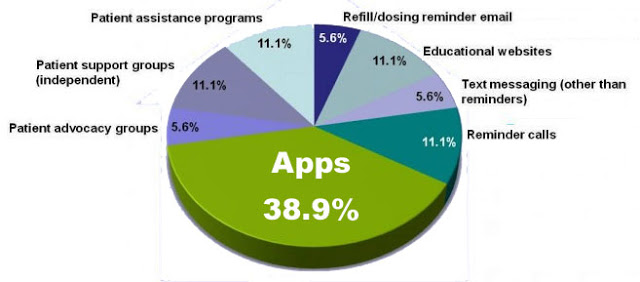US pharmaceutical companies’ patient adherence budget allocations have increased from $400,000 in 2009 to $1.5 million in 2012 — a 281% jump. That is according to a patient adherence survey by Cutting Edge Information (here).
The Cutting Edge Information report includes the following chart, which shows the “Patient Outreach Activities Most Likely to Increase in the Next Five Years” according to surveys and interviews of pharma marketers:
So, as I read this chart, nearly 40% of pharma marketers agree that patient adherence activities involving mobile “apps” will increase over the next five years. It appears that the “app” category here includes sending text reminder messages to mobile phones as well as downloadable applications such as the the Care4Today mobile app that was developed and recently released by Janssen Healthcare Innovation (see here).
Currently, 11% of pharma’s adherence budget is allocated to mobile “apps.” A little more than half of that is dedicated to simply calling/texting mobile phones to remind patients to take their medications, according to a MEDCity News review of the report (here). In five years, it is projected that 33% of pharma’s adherence budget will be allocated to mobile “apps.” I predict that the lion’s share of this — maybe 75% — will be allocated to apps like Care4Today with only a minor portion (25%) going to simple reminder text messaging.
If adherence budget allocations continue to increase on a pace similar to the recent past, US pharma companies may be spending nearly $3.3 billion on adherence by 2017 (i.e., the next five years). One third of that — $1.1 billion — may be dedicated to mobile “apps” (including simple text messaging) and 75% of that — $825 million — could be spent on other mobile apps like Care4Today.
Hopefully, this investment won’t be wasted on mobile adherence apps that are EXACTLY like Care4Today, the main purpose of which may be promotion of products rather than promotion of adherence (see “Adherence – Do We Really Need an App for That? Benefits Do Not Outweigh the Risks“).









![6 Digital Tools at the Center of Healthcare Digitalization [INFOGRAPHIC]](http://ec2-54-175-84-28.compute-1.amazonaws.com/pharma-mkting.com/wp-content/uploads/2021/04/6DigitalTools_600px-100x70.jpg)




